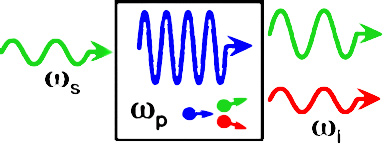Description
One of the primary goals of the ZOE project was to exploit the quantum Zeno effect in creating next-generation devices for (quantum) optical communication systems. The quantum Zeno effect is a phenomenon arising from the measurement postulate of quantum mechanics, which says that frequent measurements of a quantum system inhibits its unitary evolution. Here, measurement does not preclude environmental interactions with the system and is therefore not restricted to solely projective measurements. These interactions can be stimulated by either coherent or incoherent loss mechanisms, which can be understood in a general sense as reversible or irreversible coupling to the environment, respectively. For example, in the optical systems under consideration, two-photon absorption is an example of irreversible coupling whereas off-resonant frequency conversion is an example of reversible coupling.
Our experimental goal was to demonstrate an all-optical switch by employing the Zeno effect. The theoretical proposal used sum- or difference- frequency generation as the workhorse to accomplish this goal. The basic experimental setup is shown in the figure here. When the pump-field enters the nonlinear (micro-) cavity, the cavity field at the pump frequency is enhanced (roughly by a factor of F, the cavity finesse). Subsequently, when the signal field arrives at the cavity, it treats the highly efficient frequency conversion process as a (reversible) loss mechanism and therefore, is reflected away from the cavity – ideally, without any interaction with the pump field at all! Such a behavior is also classified as “interaction-free.” A device that functions in this manner can therefore be, in principle, lossless and robust against pump-induced (quantum) noise for the signal field.
We have demonstrated a proof-of-principle experiment in a nonlinear Fabry-Perot cavity utilizing difference-frequency generation in a bulk periodically poled Lithium Niobate crystal. However, due to the large-volume setup involved here (large is relative to the wavelength of light), large pump powers (on the order of 10W) were required to observe these effects. The reason is that we want the cavity field at the pump frequency to build up so much that the “measurement” on the signal field needs to be very strong for it to not enter the cavity at all, i.e., to observe the interaction-free coupling between the pump and signal fields. However, in a high-Q whispering gallery mode resonators, these pump power restrictions are effectively eliminated due to the large Finesse (F ~ 6000 was observed in our setups). We have observed strong sum-frequency generation in a whispering-gallery mode resonator and have also seen signatures of a strong interaction-free coupling between the signal and pump fields at a microwatt-power level, showing nearly four orders of magnitude improvement in terms of power required compared to the F-P cavity demonstration.
Publications
(1) Y.-P. Huang and P. Kumar, "Interaction-free all-optical switching in χ(2)microdisks for quantum applications," Opt. Lett. 35, 2376,http://dx.doi.org/10.1364/OL.
(2) Y.-P. Huang, J. B. Altepeter, and P. Kumar, "Interaction-Free All-Optical Switching via the Quantum Zeno Effect," Phys. Rev. A, 82, 062826,http://dx.doi.org/10.1103/
(3) Y.-P. Huang and P. Kumar, "Interaction-Free Quantum Optical Fredkin Gates in Microdisks," Selected Topics in Quantum Electron.,IEEE Journal of, http://dx.doi.org/10.1109/
(4) Y.-P. Huang, A. S. Kowligy, J. B. Altepeter, and P. Kumar, "Interaction-Free All-Optical Switching via Quantum Zeno Blockade," Frontiers in Optics, 2011, http://dx.doi.org/10.1364/FIO.
(5) K. T. McCusker, Y.-P. Huang, A. S. Kowligy, and P. Kumar, Phys. Rev. Lett. (submitted)
(6) D. V. Strekalov, A. S. Kowligy, Y.-P. Huang, and P. Kumar, Phys. Rev. Lett. (submitted)
(7) D. V. Strekalov, A. S. Kowligy, Y.-P. Huang, and P. Kumar, Phys. Rev. Lett. (in preparation)
(8) Y.-P. Huang and P. Kumar, "Antibunched emission of photon pairs via quantum Zeno blockade," Phys. Rev. Lett. 108, 030502,http://dx.doi.org/10.1103/
(9) A. S. Kowligy, Y.-P. Huang, and P. Kumar (Invited Talk to Heraeus Seminar on "Micro- & Macro-cavities in classical and nonclassical light") (2011)
(10) Y.-P. Huang and P. Kumar, "Fredkin Gates in χ(2) Microdisks via Quantum Zeno Blockade," Nonlinear Optics Conference, NWE Poster Session(2011)
(11) K. T. McCusker, Y.-P. Huang, A. S. Kowligy, and P. Kumar, (Accepted to Coherence and Quantum Optics/Quantum Information and Measurement 2013)
(12) Y.-Z. Sun, Y.-P. Huang, and P. Kumar, Phys. Rev. Lett., 2013 (accepted)

